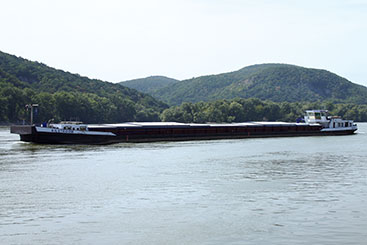Enhanced Cooperation: a closer look at navigation in the EU Strategy for the Danube Region

Enhanced Cooperation: a closer look at navigation in the EU Strategy for the Danube Region
Two years after the Danube Strategy was launched, and it looks like smooth sailing for the strategy’s Priority Area 1a – Navigation.

One major milestone for Priority Area 1a on navigation was the signing of the Declaration on Effective Waterway Infrastructure Maintenance on the Danube and its Navigable Tributaries, which stresses obligations to maintain the fairway to a good standard. © ICPDR/Liska
The EU Strategy for the Danube Region (EUS DR) is a macro-regional strategy adopted by the European Commission in December 2010 and endorsed by the European Council in 2011. The Strategy seeks to create synergies and coordination between existing policies and initiatives taking place across the Danube region and addresses 4 thematic pillars and 11 priority areas.
Coordinating efforts across the Danube River Basin. Each priority area is managed by two Priority Area Coordinators (PACs); the Navigation Priority Area is led by Austria and Romania. To coordinate the discussion on existing and proposed projects in line with the objectives set for Priority Area 1a, the PACs together with the Steering Group established five thematic Working Groups on waterway infrastructure and management, ports and sustainable freight transport, fleet modernisation, River Information Services and education and jobs.
A Steering Group advises and assists the implementation of Priority Area 1a and ensures that actions are anchored all over the region and in all participating states. Furthermore, the Steering Group is responsible for the labelling of projects. Working Groups serve as a dialogue platform between waterway administrations and the Danube Commission, as well as public and private stakeholders. To tap the latest available knowledge for the Strategy’s implementation, regional and international experts are consulted and invited to the sessions of the Working Groups.
Assessing the progress. In April 2013, the European Commission published the first Progress Report concerning the implementation of the EUSDR. The paper promotes concrete transnational projects which have a strong impact on the region and focuses on the region’s political importance through strategic support at the ministerial level.
Furthermore, at the latest meetings of the Working Groups and the Steering Group in Linz, held on April 16–18, 2013, more than 100 participants discussed the progress of the EUSDR’s Priority Area 1a, among these representatives from ministries of the Danube countries, the European Commission, the navigation industry, international industry associations, national and local authorities, inter-governmental and nongovernmental nongovernmental organisations, universities and research institutions as well as project coordinators.
NAVIGATION OBJECTIVES
For Priority Area 1a (PA 1a) – To improve mobility and multimodality: Inland waterways – five targets were agreed by the 14 Danube states:
- Increase the cargo transport on the river by 20% by 2020 compared to 2010.
- Solve obstacles to navigability, taking into account the specific characteristics of each section of the Danube and its navigable tributaries and establish effective waterway infrastructure management by 2015.
- Develop efficient multimodal terminals at river ports along the Danube and its navigable tributaries to connect inland waterways with rail and road transport by 2020.
- Implement harmonised River Information Services (RISs) on the Danube and its navigable tributaries and ensure the international exchange of RIS data preferably by 2015.
- Solve the shortage of qualified personnel and harmonise education standards in inland navigation in the Danube region by 2020, taking into account the social dimension of the respective measures.
Reaching milestones. A big step in implementing the goals for Priority Area 1a was the signing of the Declaration on Effective Waterway Infrastructure Maintenance on the Danube and its Navigable Tributaries at the Danube Ministers Meeting on June 7, 2012, in Luxembourg. The Declaration reasserts existing obligations to maintain the fairway to a good standard, and foresees monitoring and reporting on the implementation of the actions in the framework of Priority Area 1a.
On the project level, more than 90 projects have been reported to or identified by the Ccoordinators of PA 1a which are relevant for the implementation of the defined measures. The PACs promote concrete transnational projects and new initiatives to action in the region.
Another achievement is the coordinative support concerning different national and EU policies and funds with the aim to create more coherence and better results regarding the improvement of mobility and multimodality on inland waterways. This includes strengthening internal implementation structures to ensure sustainable leadership and strategic planning, to monitor continuously the implementation of all Priority Areas with a focus on specific challenges, and to report calls on EU Member States to incorporate the targets of the EUSDR into the new generation of programmes for the 2014–2020 period.
Taking cooperation to another level. For successful implementation of the EUSDR, horizontal cooperation with other PACs is crucial. Cooperation with Priority Area 6 on biodiversity contributes to the sustainable implementation of the Joint Statement on Guiding Principles Concerning the Development of Navigation and Environmental Protection in the Danube River Basin. The Joint Statement summarises principles and criteria for environmentally sustainable inland navigation on the Danube and its tributaries, including the maintenance of existing waterways and the development of future waterway infrastructure.
This kind of intense cooperation will contribute to meeting the EUSDR goals for navigation – and those of all the priority areas – across the entire Danube River Basin.
For more information on the EU Strategy for the Danube Region and Priority Area 1a on inland waterways, please visit: www.danube-navigation.eu.





